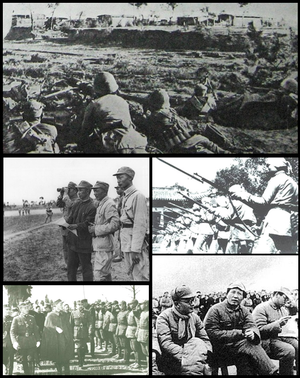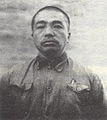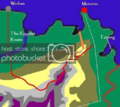Long War
| Long War 長期戰爭/长期战争 | |||||||
|---|---|---|---|---|---|---|---|
 | |||||||
| |||||||
| Main Belligerents | |||||||
| Commanders and leaders | |||||||
| Strength | |||||||
|
X million (regular) X million (military) |
X million (regular) X million (military) | ||||||
| Casualties and losses | |||||||
| xxx dead or missing, xxx wounded, xxx captured | xxx dead or missing, xxx wounded, xxx captured | ||||||
The Long War or War of Imperialist Aggression was an ideological conflict in Ide Jima. The incumbent Imperialist dynasties were threatened by revolutionary communists. Tensions boiled over when a number of protesters were fired upon and killed during a worker's protest at the then Imperial palace in the nation's capital. The conflict first began with many nations taking sides and sending support to one of the two main factions, Imperialists and Communists. The conflict then escalated into a total war. The conflict lasted from the 1930s into the 1950s, hence the name The Long War. The eventual outcome was a communist victory.[1]
Background
The incumbent Imperialist dynasties were threatened by revolutionary communists. Communists ideology gained influence thanks to new mess media such as radio. Tensions boiled over when a number of protesters were fired upon and killed during a worker's protest at the then Imperial palace in the nation's capital. Outside influence from Mat Troi Lan undermined the Ide Jiman monarchy in the hope of strengthening its own economic position.
Major factions
- Imperialists, led by Emperor Mitsuhiran III.
- Communists, led by Marshals Chang, Ryuzen, and Zatoichi.
War
This article is incomplete because it is pending further input from participants, or it is a work-in-progress by one author. Please comment on this article's talk page to share your input, comments and questions. Note: To contribute to this article, you may need to seek help from the author(s) of this page. |
(WIP. This conflict is supposed to be a combination of the Chinese civil war and later Korean War. Communist revolution, followed by trench warfare, and eventual communist victory. There will need to be technological innovations between the beginning and end of this conflict: aircraft, rockets, maybe even uranium.)
- 1930s — Internal conflicts between imperialists and communists. (Where did these communists come from? Why were the imperialists weak enough to be attacked?)
- 1933-35
- 1933 — Marshals took control and proposed the "liberation" of Ide Jima. Weeks of telegram exchanges between communists and Mat Troi Lan followed. By early spring, the marshals had secured assurances of support from Mat Troi Lan. May 1st revolution: on 1 May 1933, the Communists launched an uprising in Shinuur against the Imperialist government in Darhan. This conflict led to the creation of the Ide Jiman Communist Army. Communist uprising in the north. The main forces of the Red Army left Shinuur and headed eastwards for an assault on Zhenwei and Kaechen. Imperialist forces quickly went into hiding while the victorious members of the Communist Army occupied Kaechen. First massacres.
- 1934 — Led to an early stalemate. Imperialists were less motivated to fight their brothers and die for the emperor.
- 1935-40 — The conflict evolved into a proxy war when outside actors took sides and sent support to one of the two main sides, Imperialists and Communists. (No foreign boots on the ground.)
- 1935 — Secondary front established. A massive artillery barrage from the Communists signalled the beginning of the second phase. Communists launched its full-scale invasion of central Ide Jima. Roughly 100,000 communist troops poured across the frontline, driving back the imperialists. The well-equipped communist troops overran imperialist defenders in central and coastal Ide Jima.
- 1936 — Marshals took control of Serekan, the former capital. Communists claimed leadership of Ide Jima. However, there was no real victor to the war at this point.
- 1937 — Death of Marshal Chang.
- The support from Deltannia is its own proxy for Volsci. (This indirect support would later come back to bite Volsci in the ass.)
- Orioni is almost obliged to support the imperialists.
- What role did San Ba and Kotowari play?
- 1940-45 — The conflict then escalated into a total war within Ide Jima (akin to World War I).
- 1940-1975 — Humanity enters the Atomic Age.
- 1941 — Spillover into the Thalassan War (1941-1947).
- 1942 — Severe famine.
- 1943 — Severe famine.
- 1945-50
- 1945 — Death of Marshal Ryuzen.
- 1947 — Following the Mat Troi Lan defeat in the Thalassan War, the Communists lost one of their strongest allies and supporters.
- 1949 — Imperialist troops reached their farthest point of advance when they recaptured Serekan. Months of fighting had increased the area under their control.
- 1950-55
- 1950 — Humanity enters the Jet Age.
- 1950 — Having destroyed a large portion of the communist army, Imperialist troops pressed on and approached the $Name River.
- 1951 — Battle of the Bridges at Toko-San. Imperialist forces pushed to destroy heavily protected bridges in communist territory. In the attack on the bridges, the anti-aircraft fire is intense. Imperialist jets managed to destroy the bridges, but with heavy losses, severely weakening the imperialist airpower. A Pyrrhic victory. With Imperialists lacking air cover, the communists launched a counter-offensive with ground troops. The communists successfully overwhelmed the Imperialist positions. This decisively shifted the balance of power towards the communist side.
- 1952 — A force led by Marshal Zatoichi staged an audacious amphibious landing at Kusan, some 100 kilometres behind enemy lines. The plan was a major success.
- 1953 — The sudden appearance of Communist forces in Kherbayan sent the main body of Imperialist forces reeling back to Altanserleg.
- 1954 — Communists captured some important cities.
- 1955 — Communists clearly on the winning side.
- 1956
- Communist forces captured Darhan. The city had been devastated by fighting. Its population was reduced to a fraction of its pre-war size.
- Truce
- Peace conference.
- The monarchy in Ide Jima was abolished. Emperor fled to another country.
Aftermath
In Ide Jima itself, the communists cemented their position.
- The eventual outcome was a communist victory.
- Reunification of Ide Jima.
- 1956-1992 — Ide Jima was officially governed by a hard line communist government.
- (WIP. How could Emperor Artakai I return in 1992?)
Outside of Ide Jima the impact was more varied.
- 1950s-60s — Spread of communism in other countries. More influence for the victors.
- The outbreak of the war convinced royalist leaders of the growing threat of international communism.
- Decolonisation movements in the final remaining Orinese outposts.
- 1957 — Assembled Nations charter signed.
- 1959 — Deltannia gained its independence from Volsci, partly thanks to support from Ide Jima.
References
- ↑ The Long War (7 November 2005)







